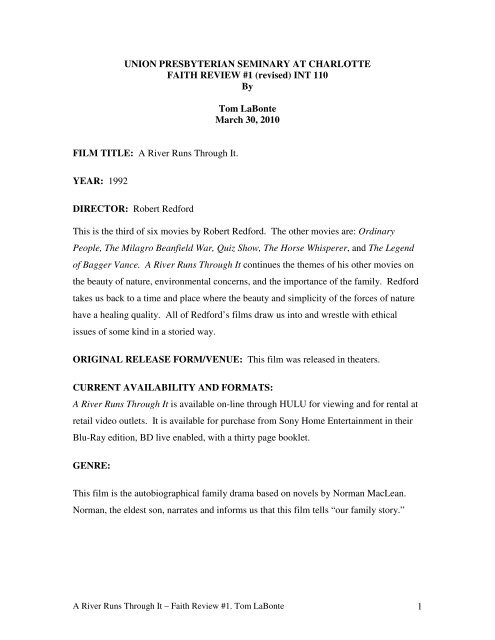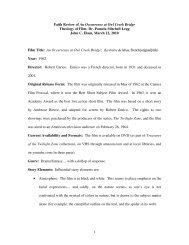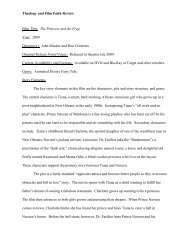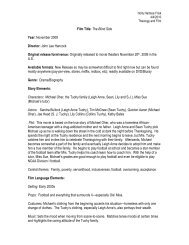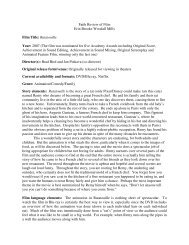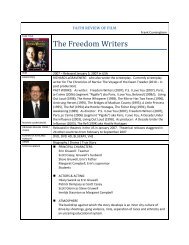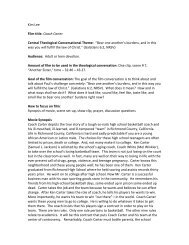A River Runs Through It - Union Presbyterian Seminary
A River Runs Through It - Union Presbyterian Seminary
A River Runs Through It - Union Presbyterian Seminary
- No tags were found...
Create successful ePaper yourself
Turn your PDF publications into a flip-book with our unique Google optimized e-Paper software.
UNION PRESBYTERIAN SEMINARY AT CHARLOTTEFAITH REVIEW #1 (revised) INT 110ByTom LaBonteMarch 30, 2010FILM TITLE: A <strong>River</strong> <strong>Runs</strong> <strong>Through</strong> <strong>It</strong>.YEAR: 1992DIRECTOR: Robert RedfordThis is the third of six movies by Robert Redford. The other movies are: OrdinaryPeople, The Milagro Beanfield War, Quiz Show, The Horse Whisperer, and The Legendof Bagger Vance. A <strong>River</strong> <strong>Runs</strong> <strong>Through</strong> <strong>It</strong> continues the themes of his other movies onthe beauty of nature, environmental concerns, and the importance of the family. Redfordtakes us back to a time and place where the beauty and simplicity of the forces of naturehave a healing quality. All of Redford’s films draw us into and wrestle with ethicalissues of some kind in a storied way.ORIGINAL RELEASE FORM/VENUE: This film was released in theaters.CURRENT AVAILABILITY AND FORMATS:A <strong>River</strong> <strong>Runs</strong> <strong>Through</strong> <strong>It</strong> is available on-line through HULU for viewing and for rental atretail video outlets. <strong>It</strong> is available for purchase from Sony Home Entertainment in theirBlu-Ray edition, BD live enabled, with a thirty page booklet.GENRE:This film is the autobiographical family drama based on novels by Norman MacLean.Norman, the eldest son, narrates and informs us that this film tells “our family story.”A <strong>River</strong> <strong>Runs</strong> <strong>Through</strong> <strong>It</strong> – Faith Review #1. Tom LaBonte 1
STORY ELEMENTS:The McClean family comprises the father, a <strong>Presbyterian</strong> Pastor, his wife, and two sons,Norman and Paul. Norman narrates the film and the story is told from his point of view.The plot revolves around the healing and bonding qualities of fly-fishing through the upsand down of life experienced by the McClean family. The first third of the film dealswith the early upbringing and fly-fishing education of Norman and Paul. In the openingscenes he tells us in this family there was no clear line between religion and fly-fishing.The father is a passionate fisherman and emphasizes in his sermons that the discipleswere fishermen. He teaches the boys to fly-fish at an early age. Paul is clearly a betterfisherman than Norman and over time becomes an excellent fly fisherman. Norman isthe sober, studious son while Paul is a daredevil, full of energy and a leader among hisage group. This is evident in the scenes of “shooting the chute” where Paul influencesNorman to take a rowboat down the river rapids as their friends watch.The middle third of the film begins with a shift forward over a few years as Normanleaves home to attend Dartmouth to study journalism. Paul stays home and becomes ajournalist in the local newspaper because he is unwilling to “leave the fish.” Afterearning his degree in literature at Dartmouth, Norman returns home in the spring of 1926while he waits to see if his job application to be a professor of literature is approved. Thebrothers reunite and go fishing at their favorite spot. Norman watches Paul cast a“rainbow arc” and as narrator acknowledges with admiration his brother’s artistry.While Norman has been away, Paul has pursued the fast life of drinking and gamblingheavily with unsavory characters, falling into serious debt. He is well known to thePolice and in one scene Norman is called to pick up Paul because he was arrested forfighting. Mabel, his Native American girlfriend is passed out at his feet. Norman offersPaul money or anything else he needs to get him straightened out. <strong>It</strong> is an offer of love,an offer to change his life. Paul does not accept the offer.In one of the following scenes Jessie, Norman’s girlfriend asks him a question for whichhe has no answer. “Why is it people who need help the most won’t take it?” ThisA <strong>River</strong> <strong>Runs</strong> <strong>Through</strong> <strong>It</strong> – Faith Review #1. Tom LaBonte 2
question is a theme of the film. Paul takes Norman out to celebrate Norman’s declarationof love for Jessie. They go to Lolo’s, Paul’s hang-out. Norman sees a seedy collection ofprostitutes, gamblers, drunks and toughs. Paul gets into a heated discussion with thegambler who won’t let him play. Norman asks Paul to leave with him but Paul feels thathe is “hot” and wants to gamble. Norman tells him he is up to his neck in debt and urgeshim to leave. “<strong>It</strong>’s my debt.” Paul again rejects his brother’s help. In these scenes thestory very much depicts the depth of the “human condition.”The final section of the film begins with a shift to the following morning as Norman, hisfather and mother, are seated around the breakfast table. When Paul walks in and joinsthem Norman tells of his offer and acceptance of a teaching position at the University ofChicago. Paul looks sad at the thought of his brother leaving but is also proud of him andhappy for his opportunity. The father and his two sons leave to go to their favoritefishing spot. Norman makes one more attempt to help save Paul from destruction, andasks Paul to come with him and Jessie to Chicago. “I’ll never leave Montana, brother.”For the third time Paul rejects Norman’s helping hand.Paul has the time of his life as he catches the largest fish in his life while being sweptdownstream. As narrator, Norman witnesses “perfection” in witness to the fishingprowess of his brother. The scene of Paul holding his prize catch, smiling in purehappiness, and the joy that his father and brother feel for him, is one of the most powerfulscenes in this film. Here the loving ties of family are demonstrated and, in a sense,renewed. The film moves forward to a call Norman receives from the Police in the darkof the night notifying him that Paul has been murdered. <strong>It</strong> falls to Norman to give thenews to his parents. The film ends with Norman narrating the theme of helping andloving others even when we do not completely understand others’ needs. The final sceneis of Norman fishing and the breathtaking view of the river. Norman tells us thateventually all things merge into one which the river runs through.FILM LANGUAGE ELEMENTS:This is a film in which the setting acts very much as a character. The film opens with ascene of a beautiful, clean, flowing stream in Montana. The cinematography, theA <strong>River</strong> <strong>Runs</strong> <strong>Through</strong> <strong>It</strong> – Faith Review #1. Tom LaBonte 3
movement and pace are intentionally slow reflecting the period. The scene shifts to amontage of pictures of the mountains, townspeople and the family. The pictures of theland, of the townspeople and of the family convey to us a different era where time movesmore slowly. The stunning beauty of the land and river remind us of the joy that can befound in simpler things. The opening scenes, narration, and cinematography make itclear that this family story will be integrally connected with nature, particularly the river.In the scenes of “shooting the chute” the beauty and colors of the river sparkle whiledanger in the speed of the river and falls are evident. The pace of the film varies as thecamera follows the boat from the shore as it speeds down the river. The pace acceleratesand we experience the speed of the boat and the mounting excitement of Norman andPaul by alternating long and close up shots. The scene shifts to a long shot of the riverahead, then quick scenes of navigating boulders through narrow channels with courageand skill. They go over the high waterfall and the scene shifts to the boat crushed andbeached on the shore. Paul is thrilled with this experience while Norman, bruised andbattered, sits alone and seems dazed in disbelief that he survived. This scene frames thevery different approaches of each brother to life in general.The scene at Lolo’s is in sharp contrast to the light, beautiful scenes associated with theriver and fishing. Paul takes Norman to his hang-out and the darkness of the night andthe drab, subdued colors of Lolo’s interior convey the darkness of Paul’s world ofdrinking and gambling addiction. The breakfast scene and final fishing scenes thatfollow the next day continue the contrast with Lolo’s. The action of the film shifts to thelight of morning as Norman, Paul, father and mother are seated around the breakfast tableenjoying each others company and the familial bond of love. This is the prelude toNorman, Paul and their father going fishing for the final time together. Paul’s moment ofglory in his life is catching the largest fish he has ever caught. The close-up of Paulsmiling proudly as Norman takes his picture and Norman’s comments that at thatmoment Paul stood suspended above earth and its laws, is a powerful climax in Paul’slife and the shared love in this family. After Paul’s death the film shifts to an overheadshot of the river, glowing in the golden light of the setting sun. <strong>It</strong> is a scene of stunningA <strong>River</strong> <strong>Runs</strong> <strong>Through</strong> <strong>It</strong> – Faith Review #1. Tom LaBonte 4
eauty conveying the tranquility and peace enjoyed in the simplicity of nature and the joyof fishing.AUDIENCE/CULTURAL CONTEXT ELEMENTS:This film has themes and a plot line that conveys a message which teenagers and adultswill understand. While the film is rated PG, some of the scenes contain language,drinking, gambling and rear-view nudity that make it inappropriate for an audience belowthe age of thirteen. While the joys of fly fishing may be out of context for an urbanaudience, the bonding, peace and love within a family is an association that peopleregardless of geographic location and lifestyle should connect with and understand.THEOLOGY IS FOUND:From the very beginning of this film it is clear that healing properties and peaceassociated with the river and fly-fishing have religious connotations. For the father, as<strong>Presbyterian</strong> Pastor, the river is a source for hearing the words of God and fly-fishing an“act of grace and an art that doesn’t come easy.” I believe Robert Redford makes astrong connection between the spiritual qualities of experiencing the river (water) and thereconciliation and renewal possible through fly-fishing in this river. The association ismade early in the film as the father tells his sons that the word of God is spoken and maybe heard as the water in the river courses over and around the rocks. The implication isthat God is all around us in nature if we take the time to truly listen. Reconciliation andrenewal are accomplished through the metaphor and symbolism of fly-fishing. The riveris a place of peace, a place where by God’s grace healing and reconciliation occur in theact of fishing. The father and boys are happiest when they are fishing at the river. Butthe power of the healing nature of the river and fishing bring them happiness even whenthey are talking about it. For Paul and his father and brother, fishing together becomesthe catalyst of the love and forgiveness they share. The passion and love of fishing of thefather and the sons are symbolic of much more than love of nature or the pleasurebrought about by technical skill. Yet, even the river cannot “save” Paul.A <strong>River</strong> <strong>Runs</strong> <strong>Through</strong> <strong>It</strong> – Faith Review #1. Tom LaBonte 5
There are certainly echoes and parallelism in the plot and themes of this film and theParable of the Prodigal Son. The characters align with the parable in that the Pastor is theloving Father; Norman is the elder son, and Paul the younger son. In his wasteful,dissolute life apart from his family, we may see Paul as the prodigal. Contrary to theparable, Norman does all in his power to try to help Paul and does not judge him; heloves him as his brother. And the times in the film when Paul comes home he iswelcomed by the whole family, father, mother and elder brother, regardless of hislifestyle of heavy drinking and gambling. Paul’s unrepentant lifestyle catches up withhim and he is killed by gamblers over his debts. <strong>It</strong> is evident to me as I exegete Luke15:11-32, that Robert Redford did not intentionally base the film on this parable. But agood theological conversation could be structured around such points and differences.After many years pass and Norman is married and has children, he and his family attenda worship service at his father’s Church where his father preaches one of his last sermonson the lessons of life. “We are willing to help but what is needed? We can still lovethem, completely, without completely understanding.” In one of the final scenes we seeNorman and Paul as two small boys, side by side on the river bank, as they were at thebeginning of the film. They are happy; they are together with the river. Norman ends themovie as an old man, alone, fishing at their favorite spot. In his narration, “alone withmy soul,” “eventually all things merge into one,” and “the river runs through it.” I amhaunted by waters.”THEOLOGICAL THEMES FOR CONVERSATION:I recommend that this film will provide a resource for examining the Biblical theme ofhow we love and serve one another. This theme is reflected in the Old TestamentProphets, in the Gospel of Jesus Christ, and in the Pauline Epistles, that we are to loveone another and serve those in need. When those in need are close to us, familymembers, friends, and others we care for, how can we help them when they refuse help?Everyone makes bad choices in life. Everyone at one time or another fails to listen toGod’s voice whispering within. Sometimes choices are made by those close to us thathurt them, us and others around us. In these circumstances how are people reconciled toA <strong>River</strong> <strong>Runs</strong> <strong>Through</strong> <strong>It</strong> – Faith Review #1. Tom LaBonte 6
one another? How and where do we find peace? For some people the beauty of nature,the clean flowing water of a stream, and the act of fishing brings peace and joy to theirhearts. When you are in spiritual pain or see others experiencing this type of pain, whatbrings peace and joy to your heart? How do you renew relationships strained or torn bythe vices or our choices in life? What does it mean to love one another in living theChristian life?SUGGESTED USE OF FILM:A <strong>River</strong> <strong>Runs</strong> <strong>Through</strong> <strong>It</strong> is a film that illustrates and clarifies the theological themes ofreconciliation and renewal of relationships. I recommend using this film as one resourcein a series of lessons with a youth group or teen Sunday School class to explore, discussand apply these themes to their lives.RECOMMENDED AMOUNT/PARTS TO VIEW AND HOW TO VIEW IT:This is a film that should be seen in its entirety at one setting to optimize the impact ofthe core themes with the audience. The class leader would have a set of questionsprepared that would include those listed in the theological themes section of this reviewas well as others to investigate the application of the themes to living the Christian life.CONCLUDING REMARKS:A <strong>River</strong> <strong>Runs</strong> <strong>Through</strong> <strong>It</strong> is a powerful drama, with captivating cinematography, and amessage that needs to be constantly reinforced that we are to love and support otherseven when we don’t understand for we are our brother’s keeper.A <strong>River</strong> <strong>Runs</strong> <strong>Through</strong> <strong>It</strong> – Faith Review #1. Tom LaBonte 7


